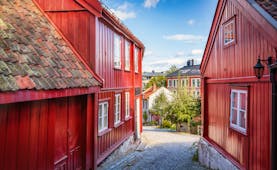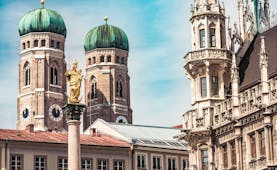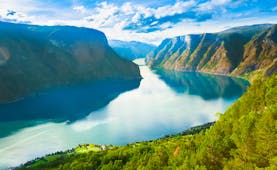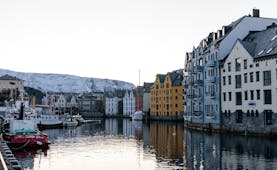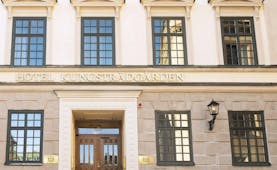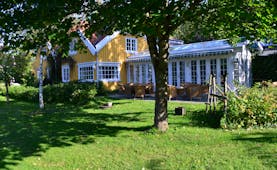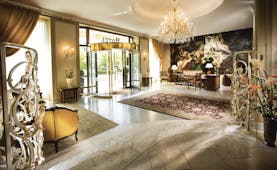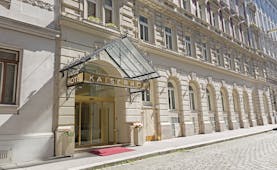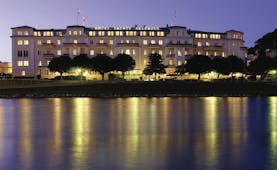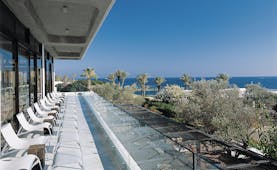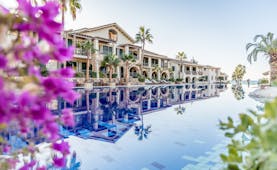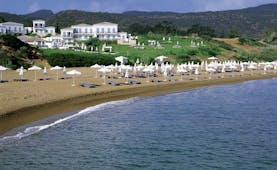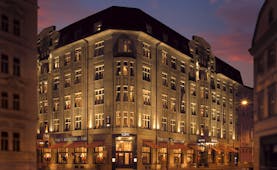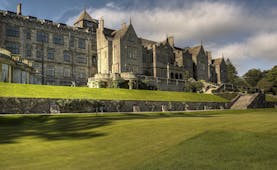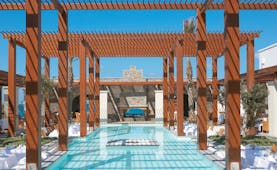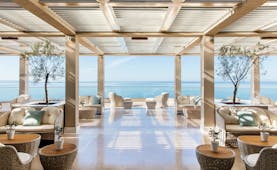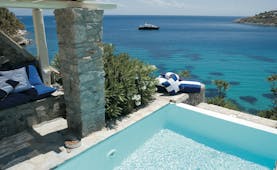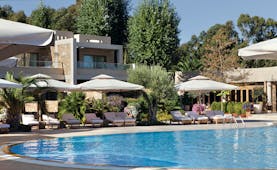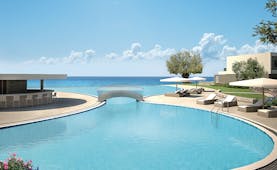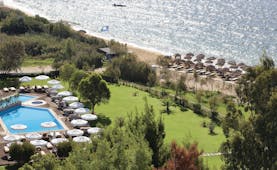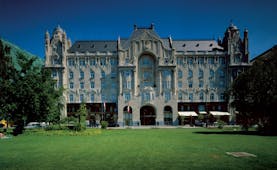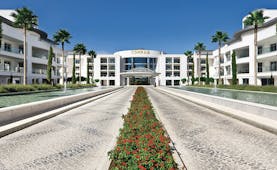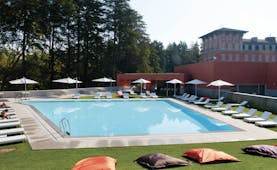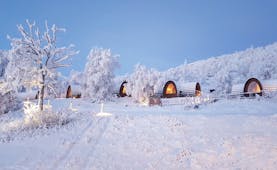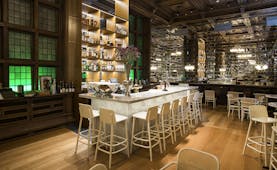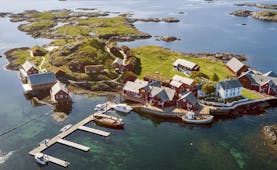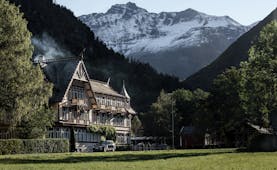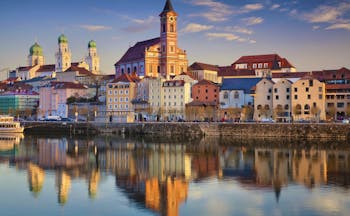Luxury 11-night rail touring holiday by train to three Scandinavian capitals plus Hamburg and Hannover
This rail holiday begins with your arrival into Hamburg by train. The city-state of Hamburg is perhaps best-known for the Speicherstadt, once the heart of Hamburg’s port and now a mesmerizing maze of red-brick canyons and canals which has been granted UNESCO World Heritage status. After one night here you travel to Copenhagen, where you will spend two nights. Denmark’s capital sits on two coastal islands and is characterised by its canals and cycling culture. Within its historical city centre you will find the Amalienborg Palace, the residence of the Danish royal family. Perhaps spend some of your time cycling around the city’s excellent cycle paths and visit one of the floating cafes on the canals. From here you travel via Gothenburg to Oslo. Norway’s capital is known for its green spaces and museums. For a deep insight into Scandinavian history a visit to the Bygdøy Peninsula is essential. This area is home to five national museums, including the Viking Ship Museum and the Fram Museum, and the rest of the peninsula is a haven for nature lovers. The Akershus Fortress is another famous landmark – completed in the 1300s, the castle is today open for guided tours and there is a poignant Museum of the Resistance in Norway within its grounds. Take time to visit the Munch museum and stroll on the sloping roof of the Opera House nearby. Choose a waterfront restaurant for dinner. After three nights here you board a direct train from Oslo to Stockholm, the final Scandinavian capital. Stockholm is located on an extensive Baltic Sea archipelago with ferries and sightseeing boats shuttling passengers between the islands. One of the main attractions here is the Royal Palace, one of the largest of its kind in Europe and the official residency of the King of Sweden. Stockholm is packed full with museums of all kinds, from the Vasa ship to the Viking museum, from a museum of the Middle Ages to the National Musuem with its art collection. At the end of your time here spend one more night in Copenhagen, perhaps using your final evening in Scandinavia to sample some one of the many trendy restaurants on the waterfront. Your final night is in Hannover, known for its rich cultural heritage. On your final day board the train at around half past ten back to Brussels, where the Eurostar will be waiting to take you back to London.
Highlights
Hamburg • Copenhagen • Oslo • Stockholm • Hannover
Day by day
Begin your Scandinavian rail tour by travelling from London to Brussels by Eurostar on an early morning departure. Upon reaching Brussels, continue to Hamburg with one more change in Cologne and check in to your hotel for one night. Historically the second largest port city in Europe, Hamburg has a wide range of attractions which display its prominence as an important cultural and commercial centre. Start your time here by exploring the warehouses and canals of the Speicherstadt, now UNESCO World Heritage Site. Contained in one of these warehouses is the Miniatur Wunderland, home to the world’s largest model railway and thousands of miniature moving parts. Another major attraction is the Museum Mile, home to five major galleries including the Kunsthalle, which displays artwork ranging from Rembrandt to Picasso. Also worth exploring are the many waterways of Hamburg; the city has three rivers – the Elbe, Alster and Bille – and more bridges than anywhere else in the world. The Jungfernstieg is a waterfront promenade in the dynamic heart of the city with a large number of flagship shops and department stores. Perhaps the best way to see the attractions on the waterfront is with a boat trip along the river. You can take in the sights of the Elbphilharmonie concert hall and the HafenCity, a new waterside quarter which is quickly growing to encompass more and more land with its creative architecture. For those interested in history a visit to St Michael’s Church is a must; this Baroque church has been destroyed by lightning and fire in its time and now offers views of the harbour from its 106-metre high observation deck.
After one night in Hamburg it is time to travel into Scandinavia. The journey to Copenhagen takes just under 5 hours and gets you in at around half past one in the afternoon, giving you plenty of time to explore after you check in to your hotel for the next two nights.
Copenhagen straddles the two coastal islands of Zealand and Amager and is characterised by its canals and laid-back atmosphere. You may want to start your time here by visiting the Amalienborg Palace which has been the residence of the Danish royal family for centuries. The museum housed within the palace features exhibits on the lives of the monarchy with its well-preserved interiors and houses the Danish crown jewels. Copenhagen has a large number of museums, the most famous of which is the SMK National Gallery, which displays a huge range of Danish and foreign art dating from the 14th century to the present day. The National Museum’s exhibits stretch back to the Stone Age, whilst the Glyptoteket art museum displays ancient and modern artwork in unique surroundings. Perhaps spend some time exploring the peaceful botanical gardens in the centre of the city which display more than 13,000 species of plants. Copenhagen is also known for being one of the most cycle-friendly cities in the world. Its broad cycle lanes and the city’s flat landscape make for a relaxing ride around the friendly streets. Perhaps finish your day with a visit to Nyhavn, the famous harbour with its painted houses and many bars and restaurants.
Today you travel from Copenhagen to Oslo, a journey of roughly eight hours with a change in the Swedish city of Gothenburg. Check in to your hotel in Oslo for the next three nights.
Oslo, the capital of Norway, sits on the country’s southern coast at the head of the Oslofjord. During your time here we highly recommend visiting the Bygdøy Peninsula, home to five national museums: The Viking Museum, the Fram Museum, the Norwegian Folk Museum, the Kon-Tiki Museum and the Norwegian Maritime Museum. The Fram Museum displays the strongest wooden ship ever built which still holds the record for sailing the farthest north and farthest south. It is possible to board the ship and see how the crew and their dogs managed to survive in the coldest and most dangerous places on earth. There are also exhibitions on the Arctic and Northwest passage. The Viking Ship Museum displays finds from four different Viking burial sites around the Oslo fjord, whilst the Norwegian Folk Museum is an open-air attraction showcasing the diverse wooden architecture and history of the country and its traditions. Another major attraction is Akershus Castle and Fortress. Completed during the 14th century, this mediaeval castle had a strategical location at the very end of the headland and withstood a number of sieges throughout the ages. Guided tours of the fortress are available during the summer. As well as museums, Oslo is known for its green spaces, the most famous of which is the Frogner Park. Within this area is the Vigeland Sculpture Park, featuring more than 200 sculptures in bronze, granite and iron and one of Norway’s top tourist attractions. Housed in some beautiful gardens of its own, the Royal Palace is the official seat of the current Norwegian King and Queen. Take a tour of the palace during the summer or stop by to see the changing of the guard at 13:30.
The final Scandinavian capital of Stockholm is reachable by direct train from Oslo. Upon arrival check in to your hotel for three nights.
Stockholm, the capital of Sweden, encompasses 14 islands and more than 50 bridges on an extensive Baltic Sea archipelago. Ferries and sightseeing boats shuttle passengers between the islands. We recommend spending some of your time here visiting some of the first-class museums it has to offer. The Vasa Museum displays the only preserved 17th-century ship in the world and a unique art treasure. More than 95% of the ship is original and it is decorated with hundreds of carved sculptures. It sank on its maiden voyage in 1628 and was salvaged 333 years later in 1961. Today, the Vasa Museum is the most visited museum in Scandinavia and tours take place every day. Five of the city’s other museums can be found within the Royal Palace. This magnificent building is the official residence of the King of Sweden and contains over 600 rooms. It was built largely during the 18th century in the Italian Baroque style and today is open to the public. As well as Queen Kristina’s silver throne you can see Gustav III’s Museum of Antiquities, the Tre Kronor Museum and the Treasury. For those interested in architecture, Stockholm’s City Hall is one of the country’s leading examples of national romanticism architecture. It features three Golden Crowns (the Swedish national coat of arms) and its tower offers fantastic views of the city. It is also well worth spending some of your time in Stockholm exploring the “Gamla Stan” (Old Town) which dates from the 12th century and is one of the best preserved mediaeval city centres in Europe.
Today you travel back to Copenhagen for one more night. Perhaps spend your time here sampling some of the city’s excellent cuisine in one of its many fine restaurants on the waterfront.
Leave Scandinavia to spend one more night in Germany on your way home, this time in Hannover. You will have the late afternoon to explore the city’s beautiful gardens, in particular the Berggarten, which is now one of the world’s leading botanical gardens. The New Town Hall resembles a palace and offers incredible views from its 93.5 metre-high observation deck. Opposite this is the Lower Saxony State museum, housed in a splendid Neo-Renaissance style building. This displays a collection of 11th to 20th century art, as well as natural history artefacts and a huge vivarium.
On your final day you leave Hannover at around 10:30 in the morning for Brussels, with one changeover in Cologne. Check in to your Eurostar service in Brussels and arrive back into London St Pancras in the evening.
My daughter and I had a fabulous time on our holiday. The hotels were all spectacular in their different ways, the train journeys were exciting and gorgeous scenery and the organisation from the various rail networks was spot on.Mrs B, June 2022
Holiday price guide From £3,115 per person based on two people sharing a double or twin room and including second class rail travel. First class and standard premier on Eurostar at a supplement of £440 per person.
Holiday Code SCBR01
Call us on 01392 441245
Luxury 11-night rail touring holiday by train to three Scandinavian capitals plus Hamburg and Hannover
Begin your Scandinavian rail tour by travelling from London to Brussels by Eurostar on an early morning departure. Upon reaching Brussels, continue to Hamburg with one more change in Cologne and check in to your hotel for one night. Historically the second largest port city in Europe, Hamburg has a wide range of attractions which display its prominence as an important cultural and commercial centre. Start your time here by exploring the warehouses and canals of the Speicherstadt, now UNESCO World Heritage Site. Contained in one of these warehouses is the Miniatur Wunderland, home to the world’s largest model railway and thousands of miniature moving parts. Another major attraction is the Museum Mile, home to five major galleries including the Kunsthalle, which displays artwork ranging from Rembrandt to Picasso. Also worth exploring are the many waterways of Hamburg; the city has three rivers – the Elbe, Alster and Bille – and more bridges than anywhere else in the world. The Jungfernstieg is a waterfront promenade in the dynamic heart of the city with a large number of flagship shops and department stores. Perhaps the best way to see the attractions on the waterfront is with a boat trip along the river. You can take in the sights of the Elbphilharmonie concert hall and the HafenCity, a new waterside quarter which is quickly growing to encompass more and more land with its creative architecture. For those interested in history a visit to St Michael’s Church is a must; this Baroque church has been destroyed by lightning and fire in its time and now offers views of the harbour from its 106-metre high observation deck.
After one night in Hamburg it is time to travel into Scandinavia. The journey to Copenhagen takes just under 5 hours and gets you in at around half past one in the afternoon, giving you plenty of time to explore after you check in to your hotel for the next two nights.
Copenhagen straddles the two coastal islands of Zealand and Amager and is characterised by its canals and laid-back atmosphere. You may want to start your time here by visiting the Amalienborg Palace which has been the residence of the Danish royal family for centuries. The museum housed within the palace features exhibits on the lives of the monarchy with its well-preserved interiors and houses the Danish crown jewels. Copenhagen has a large number of museums, the most famous of which is the SMK National Gallery, which displays a huge range of Danish and foreign art dating from the 14th century to the present day. The National Museum’s exhibits stretch back to the Stone Age, whilst the Glyptoteket art museum displays ancient and modern artwork in unique surroundings. Perhaps spend some time exploring the peaceful botanical gardens in the centre of the city which display more than 13,000 species of plants. Copenhagen is also known for being one of the most cycle-friendly cities in the world. Its broad cycle lanes and the city’s flat landscape make for a relaxing ride around the friendly streets. Perhaps finish your day with a visit to Nyhavn, the famous harbour with its painted houses and many bars and restaurants.
Today you travel from Copenhagen to Oslo, a journey of roughly eight hours with a change in the Swedish city of Gothenburg. Check in to your hotel in Oslo for the next three nights.
Oslo, the capital of Norway, sits on the country’s southern coast at the head of the Oslofjord. During your time here we highly recommend visiting the Bygdøy Peninsula, home to five national museums: The Viking Museum, the Fram Museum, the Norwegian Folk Museum, the Kon-Tiki Museum and the Norwegian Maritime Museum. The Fram Museum displays the strongest wooden ship ever built which still holds the record for sailing the farthest north and farthest south. It is possible to board the ship and see how the crew and their dogs managed to survive in the coldest and most dangerous places on earth. There are also exhibitions on the Arctic and Northwest passage. The Viking Ship Museum displays finds from four different Viking burial sites around the Oslo fjord, whilst the Norwegian Folk Museum is an open-air attraction showcasing the diverse wooden architecture and history of the country and its traditions. Another major attraction is Akershus Castle and Fortress. Completed during the 14th century, this mediaeval castle had a strategical location at the very end of the headland and withstood a number of sieges throughout the ages. Guided tours of the fortress are available during the summer. As well as museums, Oslo is known for its green spaces, the most famous of which is the Frogner Park. Within this area is the Vigeland Sculpture Park, featuring more than 200 sculptures in bronze, granite and iron and one of Norway’s top tourist attractions. Housed in some beautiful gardens of its own, the Royal Palace is the official seat of the current Norwegian King and Queen. Take a tour of the palace during the summer or stop by to see the changing of the guard at 13:30.
The final Scandinavian capital of Stockholm is reachable by direct train from Oslo. Upon arrival check in to your hotel for three nights.
Stockholm, the capital of Sweden, encompasses 14 islands and more than 50 bridges on an extensive Baltic Sea archipelago. Ferries and sightseeing boats shuttle passengers between the islands. We recommend spending some of your time here visiting some of the first-class museums it has to offer. The Vasa Museum displays the only preserved 17th-century ship in the world and a unique art treasure. More than 95% of the ship is original and it is decorated with hundreds of carved sculptures. It sank on its maiden voyage in 1628 and was salvaged 333 years later in 1961. Today, the Vasa Museum is the most visited museum in Scandinavia and tours take place every day. Five of the city’s other museums can be found within the Royal Palace. This magnificent building is the official residence of the King of Sweden and contains over 600 rooms. It was built largely during the 18th century in the Italian Baroque style and today is open to the public. As well as Queen Kristina’s silver throne you can see Gustav III’s Museum of Antiquities, the Tre Kronor Museum and the Treasury. For those interested in architecture, Stockholm’s City Hall is one of the country’s leading examples of national romanticism architecture. It features three Golden Crowns (the Swedish national coat of arms) and its tower offers fantastic views of the city. It is also well worth spending some of your time in Stockholm exploring the “Gamla Stan” (Old Town) which dates from the 12th century and is one of the best preserved mediaeval city centres in Europe.
Today you travel back to Copenhagen for one more night. Perhaps spend your time here sampling some of the city’s excellent cuisine in one of its many fine restaurants on the waterfront.
Leave Scandinavia to spend one more night in Germany on your way home, this time in Hannover. You will have the late afternoon to explore the city’s beautiful gardens, in particular the Berggarten, which is now one of the world’s leading botanical gardens. The New Town Hall resembles a palace and offers incredible views from its 93.5 metre-high observation deck. Opposite this is the Lower Saxony State museum, housed in a splendid Neo-Renaissance style building. This displays a collection of 11th to 20th century art, as well as natural history artefacts and a huge vivarium.
On your final day you leave Hannover at around 10:30 in the morning for Brussels, with one changeover in Cologne. Check in to your Eurostar service in Brussels and arrive back into London St Pancras in the evening.
My daughter and I had a fabulous time on our holiday. The hotels were all spectacular in their different ways, the train journeys were exciting and gorgeous scenery and the organisation from the various rail networks was spot on.Mrs B, June 2022
Holiday price guide From £3,115 per person based on two people sharing a double or twin room and including second class rail travel. First class and standard premier on Eurostar at a supplement of £440 per person.
Holiday Code SCBR01
Our prices include
● Rail travel from London to Hamburg and Hannover to London via Brussels
● Second-class/standard class travel on all trains (first and standard premier on Eurostar at a supplement)
● 1 night’s bed and breakfast in a Small double room at Hotel Tortue, Hamburg
● 3 nights’ bed and breakfast in a Standard double room at Hotel Ottilia, Copenhagen
● 3 nights’ bed and breakfast in a Standard room at Amerikalinjen or in a Classic double at the Hotel Continental, Oslo
● 3 nights’ bed and breakfast in a Standard double at the Hotel Kungstradgarden or in Classic king room at Lydmar Hotel, Stockholm
● 1 night’s bed and breakfast in a Standard double room at Central Hotel Kaiserhof, Hannover
● Concierge service and Expressions Holidays regional helpful hints
Our prices do not include
● Early check-in or late check-out at any hotels (although we can arrange this on request at additional cost)
● Any other services not mentioned above, such as transfers and meals except breakfast at hotels
● Personal holiday insurance. This is essential and cover should be in place from when you book the holiday.
● Possible local tourist tax, usually the equivalent of £1 to £3 per person per night, and payable locally to the hotel
● Transfers in any cities
Additional information This holiday can be arranged throughout the year. Timings can vary depending on the month and day of the week.
Call us on 01392 441245
Luxury 11-night rail touring holiday by train to three Scandinavian capitals plus Hamburg and Hannover

The Tortue Hamburg is a historic French-style hotel in the centre of Hamburg. 126 warm and elegant rooms and suites, two restaurants, three bars and three salons.
Small double room

The Hotel Ottilia is a trendy design hotel in the centre of the new Carlsberg district in Copenhagen. Smart, modern rooms, rooftop terrace with restaurant and bar, and a fitness centre.
Standard double room
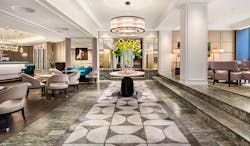
The Hotel Continental is an iconic grand hotel dating from 1900 in the centre of Oslo on Stortingsgaten. A 5-star hotel, it offers 151 elegant rooms and suites and excellent dining.
Standard double

The Amerikalinjen is a traditional yet trendy 4-star hotel in downtown Oslo. Light, modern rooms, four restaurants/bars and a large library.
Standard room

The Hotel Kungsträdgården offers a discreet insight into Gustavian Sweden with its muted colours and woodwork in its 94 cosy rooms. Excellent location.
Standard double room

The Lydmar Hotel is an elegant and modern hotel on the waterfront in central Stockholm. Newly-renovated designer rooms, restaurant, terrace and patio with regular live music.
Classic king room
My daughter and I had a fabulous time on our holiday. The hotels were all spectacular in their different ways, the train journeys were exciting and gorgeous scenery and the organisation from the various rail networks was spot on.Mrs B, June 2022
Holiday price guide From £3,115 per person based on two people sharing a double or twin room and including second class rail travel. First class and standard premier on Eurostar at a supplement of £440 per person.
Holiday Code SCBR01
Call us on 01392 441245
Luxury 11-night rail touring holiday by train to three Scandinavian capitals plus Hamburg and Hannover
About Germany
An Expressions tailor-made holiday to Germany enables travellers to experience a fascinating and richly varied country. Germany is replete with regional quirks and personalities - a strong feature of German life and a hangover from the days, not too long ago, when the country was once a patchwork of independent states. Today, to travel from the ancient ports of the north, across the open fields of the German plain, and down through the Ruhr and onto the forests, mountains and cosmopolitan cities of Germany’s Bavarian south, you’ll experience an intriguing variety as great – and appealing – as you’d find anywhere else in Europe. Several of Germany’s cities have the air of national capitals. Cologne, though enmeshed in one of Europe’s most intensively industrialised regions, is rich in monuments. Bavaria’s capital, Munich, is another star attraction, with great museums and galleries. Berlin, the nucleus of the turmoil of reunification, is now one of the most sophisticated, artistic and exciting cities on the planet, while Nuremberg is thrillingly ancient, with the most charming of winter markets in the 11th century square, and summer festivals when the cobbled streets come alive with street artists and musicians. Scattered between these city big-hitters, quieter, utterly charming cities and large towns abound, with medieval old towns straight out of fairy-tale picture books. Heidelberg, the oldest university town in Germany, is an absolute gem, nestling between wooded hills on the banks of the Neckar river, a setting that has seduced visitors ever since the days of the Grand Tour. But from Trier to Bamberg, Marburg to Meissen, Regensburg to Rothenburg, enchanting old towns abound. Beyond Germany’s beautiful cities and towns, the Bavarian Alps, right on Munich’s doorstep, are a spectacular playground for hikers and bikers, horse-riders and skiers. The Rhine and Mosel are both littered with castles and vineyards, offering an enchanting backdrop for the cruise boats that drift serenely along their waters. And stretching more than 100 miles north to south, and 45 miles from east to west, the Black Forest is awash with pretty spa towns and exquisite health resorts, crisscrossed with walking trails. The Black Forest also boasts some of the most spectacular rail journals on the planet. A beautiful, intriguing country vastly at odds with its stiff stereotype, Germany is a wonderful holiday destination for active outdoorsy types and city-breakers alike.
Highlights of Germany
Berlin’s world-class museums, bustling bars, galleries and monuments; Rugen Island, with its rugged chalk cliffs, windswept beaches, Romantic-era spa architecture and tree-lined country roads; Dresden, with its baroque beauty on the banks of the majestic Elbe; Cologne’s magnificent cathedral; the UNESCO World Heritage city of Bamberg; the sandy dunes of Sylt, a North Sea island with fabulous beaches and surf; the beer halls of Munich, ideally in September during the Oktoberfest; Lubeck, a Hanseatic gem; Muritz National Park, where you can go paddling and camping in a paradise teeming with birds; Bremen, a metropolis in miniature, with lovely red-brick and Art Nouveau architecture; the Alpine resorts of Bavaria, including Berchtesgaden, with dramatic peaks, dreamy lakes and superb walking trails; drive or cruise along the Rhine or Mosel, visiting castles, medieval villages and superb vineyards along the way; the walled medieval towns of Rothenburg and Trier, both with wonderful Christmas markets; the Christmas market at Nuremberg, oldest – and still most picturesque – in the world.
Facts in brief
Capital BerlinAirport Several airports are served from the UK, including Berlin, Bremen, Cologne-Bonn, Dortmund, Dresden, Dusseldorf, Frankfurt, Hamburg, Hannover, Stuttgart and Munich.
Size 137,000 sq. miles
Population 82 million
Call us on 01392 441245
Luxury 11-night rail touring holiday by train to three Scandinavian capitals plus Hamburg and Hannover
About Denmark
Denmark is a charming and vibrant country that works as a great starting point for a Scandinavian touring holiday or as a delightful, culinary and historic destination in its own right. From its modern cities to its varied landscapes of fjords, sand dunes and beaches, Denmark is a cultural, historical and scenic haven which teems with opportunities. The country is generally divided into different regions, each one with its own distinct character and charm. Northern Jutland is known as the Land of Light with its long summer days, wonderful beaches and rolling moorland which have inspired painters for centuries. Further south on the same island, Southern Jutland is home to the lively city of Aarhus where culture abounds, and trendy bars and restaurants line the streets. This area also solidifies Denmark’s reputation as a family-friendly destination with the crowd-pleasing Legoland. Over on Denmark’s largest island of Zealand, visitors can witness first-hand what attracted early Viking settlers: picturesque waterways giving way to a fertile heartland littered with royal castles, formidable fortresses and noble mansions. Southern Zealand’s sandy beaches and towering cliffs set the scene for historic churches and castles, whilst lively amusement parks are perfect for families. Denmark’s cities are at the forefront of modern advancement, with its capital of Copenhagen being voted frequently as one of the world’s happiest places to live. A network of canals and waterways links an assortment of art galleries, world-class restaurants, regal sites such as the Amalienborg and picturesque green spaces.
Highlights of Denmark
The rugged landscape of Skagen’s beaches are the perfect location to revel in the other-worldly beauty of Denmark’s northernmost region, seeing first-hand the inspiration for painters throughout history. Explore the ancient monuments and stories from the Viking Age, in particular at Fyrkat and Lindholm Hoje. South of here you will find the port city of Aalborg, which marks the start of fjord country and has a historic town centre. For a more immersive experience, the town of Ribe in Southern Jutland is Denmark’s oldest and harks back to the Viking Ages with its mediaeval architecture and 1300-year history. Southern Jutland is also a popular spot for families with Legoland offering colourful characters, rides and shows. To experience more of the natural beauty of Denmark, Southern Zealand to the east of Jutland is home to imposing cliffs and beautiful beaches, interposed with majestic castles and ruins such as those in Koge and Vordingborg, the latter of which was the capital of the Valdemar dynasty during the 12th century and was an important staging post for military expeditions during this period. For relatively untouched areas head to the islands of Lolland and Falster to the south which are more rural in character and offer miles of beaches and woodland. To the north, some of the most impressive royal castles in the country can be found amongst port towns with remnants of the Viking empire: Kronborg was the setting for Hamlet and has been added to the UNESCO World Heritage Site list. On the east coast of Zealand is the capital of Copenhagen. This modern and progressive city is known for being one of the most cycle-friendly cities in the world, and this provides a wonderfully relaxed way of nagivating the green spaces, art galleries and designer stores that line the streets. The Amalienborg Palace has been the residence of the Danish royal family for centuries, and today houses a museum featuring exhibits on the lives of the monarchy and their traditions. Other popular museums include the SMK National Gallery and the National Museum, whose exhibits stretch back to the Stone Age.
Cultural highlights of Denmark
Denmark’s capital of Copenhagen is home to a plethora of world-class art galleries and museums. The Statens Museum for Kunst (National Gallery) is Denmark’s largest art gallery and features works from Danish artists such as Constantin Hansen, as well as foreign art from well-known names such as Picasso. The Design Museum celebrates the history of applied arts and industrial design, while the Glyptoteket art museum displays ancient and modern artwork in unique surroundings, in particular the central conservatory, which contains exotic flora, towering palms and bewitching sculptures. The National Museum meanwhile provides an insight into Denmark’s rich history and culture, ranging from the Stone Age to Viking treasures to mediaeval art. The botanical gardens in the centre of the city display more than 13,000 species of plants, and the popular Tivoli Gardens is adored by the Danes, comprising part theme park, part cultural venue with extensive gardens and many dining options. Out of the capital city, there are a number of equally worthy museums and art galleries, in particular the Louisiana Museum of Modern Art, which features modern masterpieces all set against the backdrop of the Øresund Sound. The city of Aarhus is known for its vibrant cultural attractions and contains a multitude of museums, not least the Vikings Museum and the ARoS Art Museum, whose collection ranges from the Golden Age to the present day.
Facts in brief
Capital CopenhagenAirport Copenhagen Kastrup is the main transport hub but Billund, Aalborg, Aarhus, Esbjerg and Sønderborg all receive international flights.
Size 16,577 sq miles
Population 5.8 million
Call us on 01392 441245
Luxury 11-night rail touring holiday by train to three Scandinavian capitals plus Hamburg and Hannover
About Sweden
Sweden is a land of diversity and grandiosity, making it an ideal destination for a luxury, tailor-made holiday. The country excels in all areas from rural to urban: the picturesque wilderness of the north abounds in magical splendour, whilst the metropolitan areas to the south offer culture, history and world-class cuisine. Time in the vast northern expanses of imposing mountains, wild forests and foreboding marshes will be spent spotting wild reindeer and embarking on hiking trails and dog sledding. During the winter the night skies are lit up with the wonder of the Aurora Borealis, whilst during the height of summer night is kept almost entirely at bay by the Midnight Sun. Heading further south, waterways and agricultural land ensure a peaceful break indulging in experiencing a more laid-back, yet no less authentic, side of Swedish life. The cities to the south of Sweden offer culture and history through their collection of world-class museums such as the Vasa Museum, castles, cathedrals and restaurants. The capital Stockholm encapsulates all of this with its historic old town, chic restaurants and magnificent Royal Palace. As the largest country in Northern Europe, there are many different ways of travelling the large expanses between locations, the most iconic of which is by train, taking you from the relative warmth of the south to the frozen tundra and snow-capped forests of the north. Sweden is an enticing destination for a holiday in its own right or can be visited in conjunction with the other Scandinavian countries. With a variety of transport options you can experience multiple regions, or perhaps choose to stay in one area for longer to truly get a feel for the majesty of this country.
Highlights of Sweden
Sweden contains over 100,000 lakes, ranging from forest ponds to vast expanses of water such as Vänern, the third largest lake in Europe. Lake swimming is popular activity and there are many opportunities for water sports on some of the smaller lakes. Sweden’s freedom to roam means anyone has the right to explore freely in nature, and there are a great number of hiking trails which will allow you to take full advantage of this. Kungsleden Trail (King’s Trail) is Sweden’s longest and most famous walking trail and will take you through a varied mountain landscape and the Vindelfjällen Nature Reserve, one of the largest protected areas in Europe. Sweden is also known for its wildlife: reindeer live in the northern forests and mountains, whilst moose, wolves and bears can also be spotted in the more remote regions. Further south the landscape is interspersed with glorious castles, the most impressive of which is arguably Drottningholm just outside Stockholm, which dates from the 17th century and was one of the most lavish buildings of its era. Above the Arctic Circle the Northern Lights illuminate the night sky during winter, in stark contrast to the Midnight Sun which keeps night-time at bay during the summer months. Sweden has a strong Viking heritage which can still be seen at archaeological sites of burial mounds, wood huts and museums. Some of the best of these can be seen in the capital of Stockholm, in particular the Viking Museum and the Birka Museum, the latter of which was an important Viking Age trading centre during the 9th century. Stockholm’s Gamla Stan (Old Town) is where the city was founded in 1252 and is home to the city’s cathedral, which has been at the heart of religious and political life in Sweden since its construction in the 13th century. The Royal Palace is the official residence of the King and Queen of Sweden and was built largely during the 18th century in the Italian Baroque style. New Nordic restaurants line the streets and squares, where you can try everything from local game to seafood classics.
Cultural highlights of Sweden
Viking treasure and artefacts in museums around the country. Folk tales and mythology. A wide variety of museums in Stockholm, including the ABBA Museum and the Vasa Museum. Midsummer celebrations in late June. Buffet-style Smögåsbord meals and specialities such as kroppkakor (potato dumplings).
Facts in brief
Capital StockholmAirport Stockholm is the main transport hub for Sweden with four international airports serving the city
Size 173,860 sq. miles
Population 10.2 million
Call us on 01392 441245
Luxury 11-night rail touring holiday by train to three Scandinavian capitals plus Hamburg and Hannover
About Oslo and Oslofjord
Norway's capital city, Oslo, nestles at the end of the Oslofjord surrounded by hills and islands. Oslo blends skilfully tradition and modernity. The iconic Oslo Opera House on the waterfront sits a short distance from the Akershus fortress and the Old Town Hall dating from 1641 is a stroll away from the Akrobaten pedestrian bridge, a near-futuristic construction of steel and glass. Much of Oslo is within walking distance from the centre and you can explore happily on foot for much of your stay. You'll notice that cars are very much absent from the centre and that trams are a very easy way of reaching places on the outskirts. A fast train serves the airport and there are numerous ferries from the harbour in front of the town hall that take you to the islands in the fjord and to historic villages along the coast.
Highlights of Oslo
Waterfront, Opera House, Akershus Fortress, Norwegian Resistance Museum, Frogner Park, Bydoy and its museums, Oslo city museum, Fjord cruise
Cultural highlights of Oslo
Munch museum, National museum, Viking Ship Museum, Kon-Tiki Museum, Astrup Fearnley Museum
Festivals of Oslo
Norwegian Wood music festival in June, Oslo World music festival, Christmas, Easter, Oslo Medieval Festival at the end of May, Oslo Chamber Music festival held in August, Oslo Jazz Festival held in August, Holmenkollen ski festival
Gastronomy of Oslo
Seafood of all sorts as well as game







